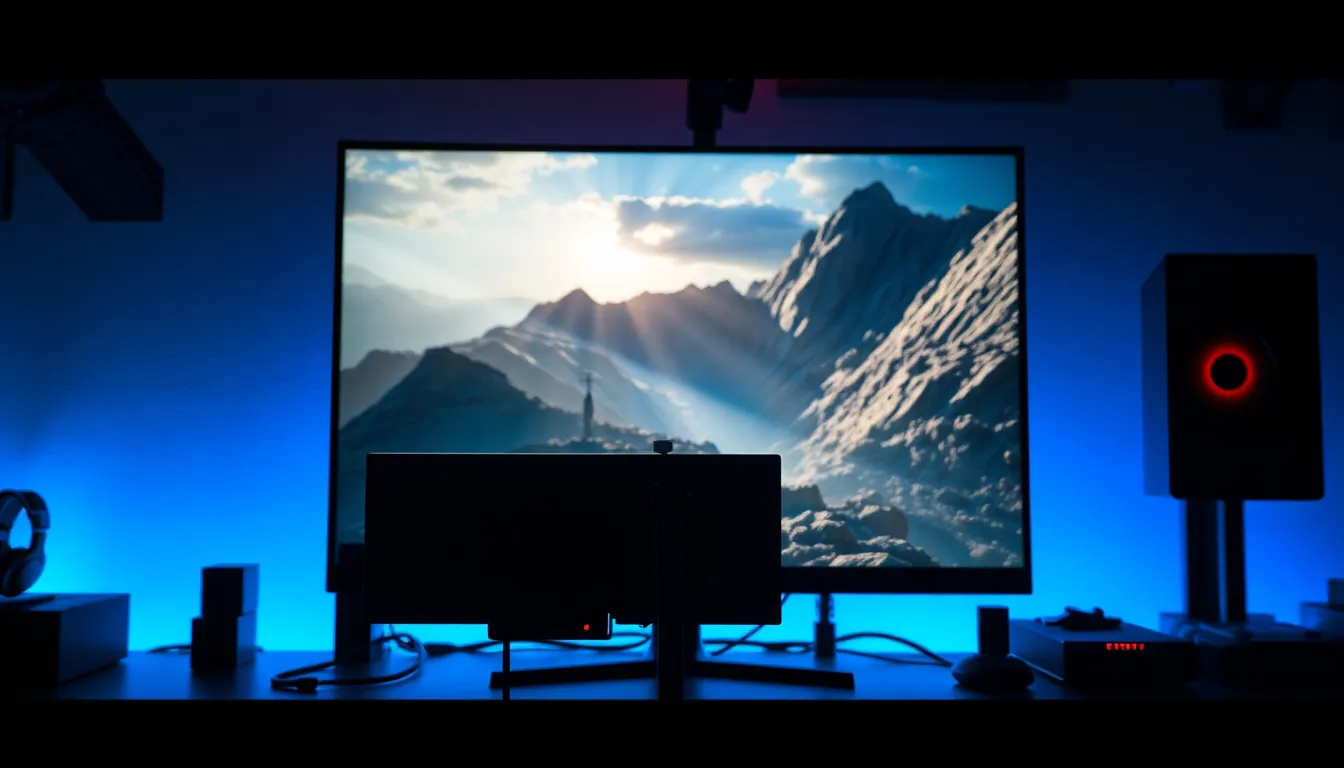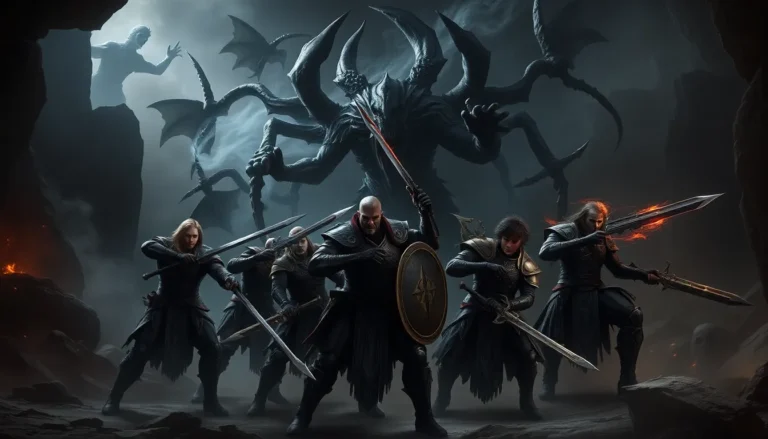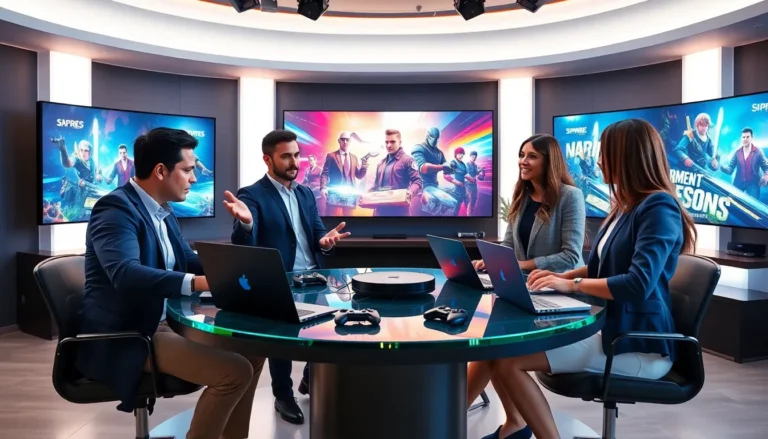Imagine a world where shadows dance with stunning realism and reflections are so lifelike they might just give you a double take. Welcome to the realm of real-time ray tracing games, where cutting-edge technology transforms ordinary gameplay into an extraordinary visual feast. Gamers everywhere are ditching their old graphics settings for a slice of this shiny new pie.
Table of Contents
ToggleOverview Of Real-Time Ray Tracing Games
Real-time ray tracing significantly elevates the gaming experience through advanced graphics technology. This method simulates the path of light to create realistic images with accurate shadows, reflections, and highlights. Gamers notice the impact in titles that leverage this technology, experiencing environments that feel immersive and vibrant.
Many popular games incorporate real-time ray tracing, enhancing visual fidelity. Notable examples include “Cyberpunk 2077,” “Control,” and “Minecraft.” Each title illustrates the potential of this technology, offering players visually stunning scenes that showcase the capabilities of modern hardware.
Game developers actively adopt ray tracing techniques to produce breathtaking graphics. Companies like NVIDIA and AMD supply the necessary hardware, enabling smoother execution of these complex visual processes. As a result, players are likely to invest in updated graphics cards that support ray tracing.
The demand for realistic graphics continues to shape the evolution of gaming. As more titles implement ray tracing, the standard for visual quality in games rises. Gamers find themselves captivated by the level of detail and realism, which traditional rendering methods can’t achieve.
In terms of performance, real-time ray tracing does require significant computational power. Optimizing games to balance performance and visual quality remains a key focus for developers. Many players appreciate options that allow them to adjust settings, tailoring the experience to their hardware capabilities.
The Technology Behind Real-Time Ray Tracing

Real-time ray tracing represents a breakthrough in gaming graphics technology. It simulates the way light interacts with objects, producing visuals that closely resemble reality.
What Is Ray Tracing?
Ray tracing, a rendering technique, calculates the paths of rays emitted from light sources. This process determines how light bounces off surfaces, creating realistic shadows and reflections. It operates by tracing these rays as they travel through a scene, interacting with various elements. By simulating optics, ray tracing offers depth and detail that traditional rasterization can’t match. This enhances overall visual fidelity in gaming environments, making them feel immersive and authentic. Games leveraging this technology showcase more lifelike visuals, increasing player engagement.
How Real-Time Implementation Works
Real-time ray tracing employs advanced algorithms to render scenes on-the-fly during gameplay. Graphics processing units (GPUs) use dedicated hardware to accelerate this complex computational task. NVIDIA’s RTX series and AMD’s RDNA architecture enhance performance, providing players with smooth frame rates. By calculating light interactions dynamically, these technologies maintain visual quality while adapting to various hardware capabilities. Developers optimize ray tracing by balancing its demands against overall game performance. Techniques such as adaptive quality and selective ray tracing enable efficient rendering without sacrificing detail. This level of optimization allows for breathtaking graphical experiences in real-time gaming.
Notable Real-Time Ray Tracing Games
Several games leverage real-time ray tracing to create immersive environments and striking visuals. Here are notable examples that highlight this technology’s potential.
Game 1: Cyberpunk 2077 Features
“Cyberpunk 2077” stands out for its expansive open world and detailed graphics. Players experience dynamic lighting that enhances the cybernetic aesthetic. Ray tracing powers realistic reflections in glass and water surfaces, allowing environments to shimmer. The atmospheric effects contribute to an engaging narrative, with NPCs reacting to the environment. Players adjust graphical settings to balance performance and visuals based on their hardware capabilities.
Game 2: Control Features
“Control” offers a unique combination of supernatural elements and ray tracing technology. Players navigate a shifting world where lighting dramatically affects gameplay. Ray tracing generates accurate shadows that add depth to encounters. Realistic reflections enable players to view their surroundings authentically, immersing them in the narrative. The game’s environments benefit from detailed textures, enhancing the overall aesthetic experience while supporting the storytelling elements.
Impact On Gaming Graphics
Real-time ray tracing significantly transforms gaming graphics, creating immersive and visually stunning experiences. It enhances realism in various aspects, including shadows and reflections.
Visual Improvements
Ray tracing technology introduces unprecedented visual fidelity. Accurate shadows bring depth to scenes, while dynamic reflections simulate real-world interactions between light and surfaces. Gamers experience environments that react to light changes, enhancing immersion. Notable titles like “Cyberpunk 2077” and “Control” illustrate this impact, showcasing realistic water reflections and nuanced lighting. Enhanced textures and materials further elevate graphic quality, making scenes appear lifelike. Improved visual effects, including global illumination and ambient occlusion, also contribute to overall realism. This advancement not only captivates players but also sets a new benchmark for graphical excellence in gaming.
Performance Considerations
Performance plays a crucial role in implementing real-time ray tracing. Advanced GPUs, like NVIDIA’s RTX series and AMD’s RDNA architecture, provide the necessary power to run ray tracing efficiently. Developers face challenges balancing visual quality with game performance, often using techniques like adaptive quality and selective ray tracing. These methods dynamically adjust graphical settings based on hardware capabilities, ensuring smooth gameplay. While ray tracing enhances visuals, it requires substantial computational resources. Gamers often find performance varies based on the complexity of scenes and effects utilized. Optimization strategies become essential for maintaining fluid gameplay while reaping the benefits of cutting-edge graphics technology.
Future Of Real-Time Ray Tracing In Gaming
The future of real-time ray tracing in gaming appears promising, with continuous advancements enhancing graphical fidelity. Developers increasingly integrate this technology, leading to more immersive experiences that captivate players. New titles are emerging that push the boundaries of visual realism while maintaining gameplay fluidity.
Emerging hardware solutions enhance ray tracing performance significantly. Companies like NVIDIA and AMD work on next-generation GPUs, ensuring that upcoming games utilize powerful features without compromising on frame rates. Advanced algorithms also evolve, streamlining the rendering process to minimize resource demands.
Game studios focus on optimizing ray tracing techniques, allowing for better adaptability across varying hardware configurations. By implementing strategies such as dynamic resolution scaling, developers ensure that players with different systems can enjoy high-quality graphics. More titles will include adjustable settings, empowering gamers to tailor their visual experiences according to their specific hardware capabilities.
Major gaming franchises are poised to adopt real-time ray tracing more extensively. Franchise installments that utilize ray tracing will likely showcase dramatic improvements in visual storytelling. The impact on game design will be notable, with developers crafting intricate worlds that feature realistic lighting and reflections.
Players increasingly expect cutting-edge technology in their gaming experiences. This expectation drives studios to innovate, reinforcing industry standards for visual quality. As the gaming community becomes more familiar with ray tracing, it influences future direction for both game development and hardware advancements.
The future of real-time ray tracing reflects a commitment to creating extraordinary visual environments that resonate with gamers. Enthusiasts will witness titles that harness this technology, setting an exciting stage for the evolution of gaming graphics.
Real-time ray tracing represents a significant leap in gaming graphics technology. As developers embrace this innovation, players can expect increasingly immersive experiences with breathtaking visuals. The balance between performance and visual fidelity is continually being refined, ensuring that gamers can enjoy stunning graphics without compromising gameplay.
With major titles already showcasing the power of ray tracing, the future looks bright. As hardware continues to evolve, so will the possibilities for game design and storytelling. This ongoing commitment to graphical excellence not only enhances individual titles but also sets a new standard for the gaming industry as a whole.





